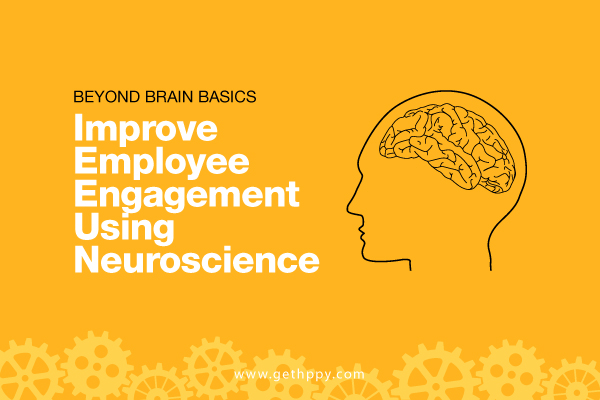Employee engagement can be a constant struggle for many leaders. They need to be thinking of new ways to keep employees engaged in order to increase job satisfaction, productivity, and retention. One of the growing factors in employee engagement is neuroscience.
Neuroscience, the study of the nervous system, can inform leaders about processes involved with their own leadership, but also about the minds of their employees. Curious to know how you can improve employee engagement using neuroscience?
Because the brain is plastic, it is always adjusting and adapting based on the environment. When you create supportive and collaborative environments, the brains of employees can process the information easier, leading to more effective change. But if the brains of employees perceive things as threats, comfort, motivation, and satisfaction decrease.
By knowing more about the brain, you can learn to limit threats. Often, those threats can come from the normal business practices of assessment, feedback, and evaluation. Because of the lasting negative impacts threats have on our brains, you also have to learn to decrease the amount of threats in the workplace, in order improve employee engagement and motivation.
The SCARF Model
Dr. David Rock is a neuroscientist who has created a model for improving the relationship between leaders and employees. He calls this model SCARF. This model stems from research that states the brain is always trying to minimize threats and maximize rewards. Moreover, social experiences follow the same reward and threat pathways in the brain that other primary needs follow.
Imagine one of our ancient ancestors coming across a new creature, plant, or water source. The brain would interpret the unknown thing as threating or safe and react accordingly. While modern humans are often not in that same position, social experiences follow the same pathways. Dr. Rock uses the SCARF acronym to explain these social forces.
S – Status
C – Certainty
A – Autonomy
R – Relatedness
F – Fairness
Status
When people feel uncertain of their social position or feel they are being evaluated, the brain interprets that environment as a threat. This threat is treated the same as a physical threat. In order to be safe, the brain has mechanisms that help us fight or run from the threat. In the case of social threats, sometimes those may not be an option, but our brains stay on high alert, making it difficult to focus on other things until the threat is gone.
As a leader, you can work to create an environment where you are not perceived as a threat. Start by allowing employees to evaluate themselves and gain insights into their behaviors. Encourage change to come from the employee instead of the leader. This way, you can decrease the threat level but also improve the engagement the employee has with company and their personal growth.
Certainty
The brain has developed to be aware of threats. Some people are more sensitive to threats than others, but everyone is able to recognize threats to some degree. The unknown can often be worse than being able to see the threat. Not knowing what will happen next increases the awareness of threats and puts the brain on high alert, making a person feel less safe and less focused on tasks.
Offer more certainty by working to increase communication with staff. Be clear in your communication and state expectations, goals, and other information that makes it evident that the you are confident and relaxed. When employees feel safe and certain in their jobs and the organization, they will be more engaged in their work.
Autonomy
Usually with any kind of change comes a choice. We have to think about when we react and how we react. Without this choice, the change (or threat) becomes even more powerful and overwhelming. It can stop us from being able to move forward and leave us unmotivated and feeling hopeless.
Make employees aware that they have choices and that they have some control over their jobs. As a direct manager, try to limit how much you interfere in an employee’s daily tasks. Your team members should be trusted to do their work without anyone constantly checking on them. This is a perfect example of how you can improve employee engagement using neuroscience.
Relatedness
People relate to one another in different ways, but often they view others as trustworthy and friendly if they feel the other person seems similar to them in some way. Often people have ways that protect them from the threat of someone new or different. These defenses can block out the things that others say or do when they are not perceived as a member of the group.
Relationship building is a vital part of a productive team. Look for ways to connect to employees and for employees to connect with each other. When everyone in a work environment is viewed as friendly, then the brain’s threat alert system is quieter, allowing people to feel more in sync with the team and with their work.
Fairness
Our brains can be very sensitive to fairness and we are usually aware of and react strongly to situations that we feel are unfair. These threats and the reactions to them can often be emotionally charged, possibly leading to anger and resentment.
To improve a sense of fairness, try to be conscious of how you interact with all employees. Don’t show any sign of favoritism or special treatment. Be transparent in all decision making processes. When fairness is at stake, address the issue at hand immediately so that there can be some understanding of why things happen.
The SCARF model uses a very basic aspect of human existence, threat and safety. We may not think about these two things on a minute to minute basis, but our brains are always reacting in ways that relate to the pathways that were created in our ancestral pasts.
As leaders or employees, we can probably all think of ways in which something we were effected by could have been looked at as our brains raising the threat alarm. With this in mind, we can learn to be more engaged leaders and employees on a brain-based level.
This article is part of our Neuroscience For Business series. View all the articles in the series here.
Image vector licensed from Graphicstock






Leave A Comment